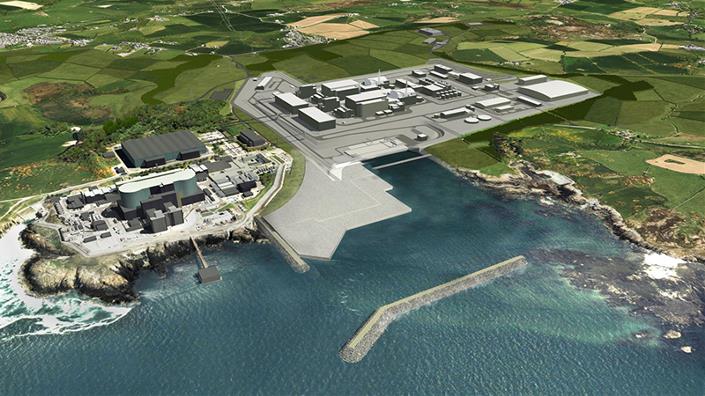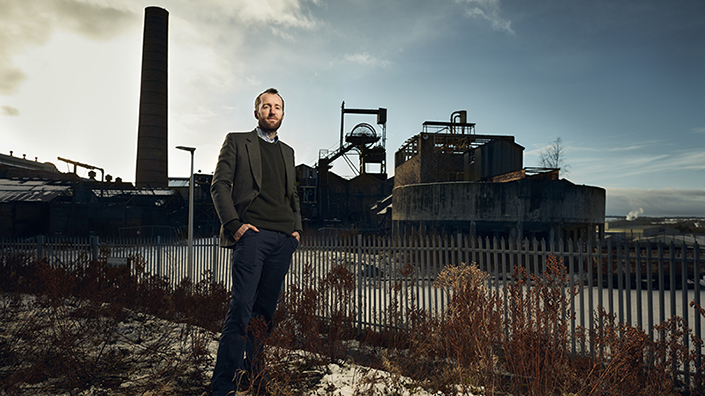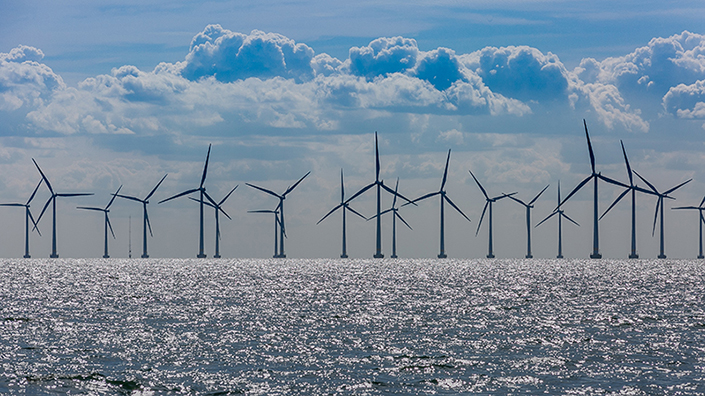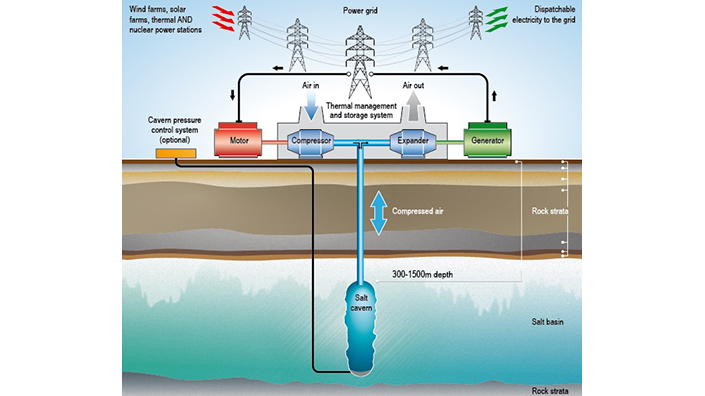The dirty black rock fuelled the engine of the Industrial Revolution, propelling the small island nation into a superpower and a world leader in engineering.
By 1920, 1.19m people toiled in coal mines stretching from the Central Belt of Scotland to Kent. But the industry went into steep decline in the 1950s, and the next three decades decimated King Coal. By the 21st century, barely any mines remained open, the country instead relying on imports from Russia, the US and Colombia. On 21 April 2017, the UK went an entire day without burning coal for electricity for the first time in 135 years, an incredible milestone in the transition to low-carbon generation.
Today, an estimated 59,000 mine shafts lie dark and disused, and some communities are still suffering from unemployment decades after the brunt of the closures. Now, however, the whirr and clank of motors and winches could once again echo through the forgotten holes, thanks to the unstoppable growth of clean energy.
New energy-storage technology could bring purpose to empty shafts, as part of a wave of projects looking underground to prevent a future energy crisis. Together, they could help keep the lights on and ensure renewable energy has the era-defining impact that coal once had.
The cold, dark doldrums
The underground technologies are aimed at solving renewable energy’s biggest problem – how to store electricity generated by intermittent sources such as wind and solar. Failing to install enough storage after switching from dispatchable, baseload generation to renewables could lead to frequent power shortages during periods of high demand, such as when millions of office workers plug their electric cars in to charge.
“What happens when the sun goes down on a windless winter evening?” asks Mark Howitt, co-founder of Storelectric, which is aiming to store energy in underground caverns as compressed air.
Increasing renewable generation could also lead to a much more serious problem, says Howitt, potentially leaving swathes of Europe without power for two weeks at a time – the kalte dunkelflaute. Sounding like a sinister fairy tale and meaning ‘the cold, dark doldrums,’ the kalte dunkelflaute is a weather pattern with very little sunshine and wind across much of Europe. Occurring roughly every two years, it could severely restrict energy generation to less than 10% of capacity.
Renewable-dependent countries would not be able to rely on renewable-dependent neighbours for imports for a fortnight thanks to the size of the weather pattern, says Howitt – long-duration storage, he claims, is part of the solution.
Nuclear cancellations – three recent cancelled projects would have supplied 15% of the UK’s demand – and the potential impact of Brexit on energy imports, which met 36% of needs in 2017, could compound the intermittency problem in the UK.

How the planned Wylfa Newydd power station in Anglesey could have looked (Credit: Horizon Nuclear Power)
Energy consumption is also set to rise globally thanks to growing populations, increasing industrialisation in developing nations and electrification of transport. “Each country is essentially having to rely on itself, and self-reliance means storage. Simple as that,” says Howitt. “It is the only way in which any country can generate enough energy for its own needs.”
Batteries, such as Tesla’s 100MW lithium-ion ‘mega battery’ in South Australia, are the best-known large-scale electricity storage technology. Easily installed compared to experimental storage methods, they also offer very good short-term rapid response. They degrade over time, however, and require cooling.
They are not well suited for discharging over more than an hour and are having a huge environmental impact in metal-rich regions. There is also not thought to be enough lithium available in the Earth’s crust for a simultaneous increase in the numbers of new electric cars, mobile devices and electricity storage units.
Pumped hydroelectric is the incumbent large-scale storage method. The systems, which pump water to uphill reservoirs to store energy, then release it to generate electricity, have been estimated to account for 97% of the world’s connected energy storage. The technology also has its issues – it is difficult and expensive to install, and reliant on the right geography of steep slopes and available water, frequently found away from urban centres of high demand. “The potential for Europe is largely used up – unless you want to flood some very well-populated valleys or beauty spots,” claims Howitt.
Plumbing old depths
Miles Franklin, lead engineer at Gravitricity, hopes to overcome the problem of intermittency with a system he describes as “a bit like solid-state pumped hydro”.
“The basic concept is the same as that inside an 18th-century grandfather clock,” he says. “You’re winding up a weight to store some energy in the position of that weight… that weight descending then powers the system for a period.”
It is a simple description – and Gravitricity is a simple concept. Huge weights between 500 and 3,000 tonnes would be suspended in shafts. During times of high renewable energy generation and low demand, electricity would flow into the installation, turning motors to lift the weight. During high demand but low generation the system would reverse, dropping the weight to turn generators within the winches, returning electricity to the grid.
The Edinburgh company is building an above-ground 250kW demonstrator, aiming to prove simulations of start-up behaviour, stable operation and predicted one-second response times. The team says the technology could eventually operate in the 1MW to 20MW peak power range, with output duration from 15 minutes to eight hours. The company predicts impressive system efficiency of 80-90%.
At first, Gravitricity aims to repurpose empty mineshafts. “There are many tens of thousands of old coal shafts in the UK, and then there is a much smaller number of old metal mines dotted around,” says Franklin. “Those appear to offer a very big opportunity – the reality is lots of them are in horrible condition and are either filled or underneath housing or other things. So the number of suitable ex-coal shafts in the UK is probably in the tens.”

Gravitricity managing director Charlie Blair (Credit: Gravitricity)
There could be greater potential abroad. Countries with coal industries that remained strong until recently are now closing mines and focusing on other energy sources, trying to meet emissions targets and Paris climate agreement goals.
“In the Czech Republic, there are hundreds of coal shafts that may be in good condition,” says Franklin. In Poland and Germany “there are also lots more shafts that have closed recently or will be closing soon, so that is a massive opportunity. Equally then you could go to South Africa, where there are many shafts over 3,000m.”
“Quite a few” mines and mining regions have contacted Gravitricity, says managing director Charlie Blair, eager to prevent a slide into disuse and decline after closure. Recently closed mines will be the initial focus, and could provide a much-needed shot in the arm for communities still reeling from the demise of the coal industry.
Franklin says: “It’s not the case that we’ll be able to employ the same numbers of people as a mine once it is operating, but there will be a long period of installation which can employ as much local labour as possible, and then in the longer term it does bring some new life to those kind of old mining assets.”
In future, however, Blair says the focus will shift to digging new shafts “to make a really big difference”. That approach would let the company build systems exactly where storage is needed – closer to cities, for example, instead of in mine shafts typically found in more rural areas.
Going underground
Instead of coal mines or new shafts, Mark Howitt’s Storelectric is focused on underground salt caverns. The company’s projects are modified versions of compressed-air energy storage (CAES). At the most basic level, CAES technology – which has been installed at sites in Germany and the US – uses renewable energy to power a motor and compressor, sucking in air and pressurising it in a container, such as an underground salt cavern. Then, in times of low generation but high demand, the air is released through an expander, turning a generator to return energy to the grid.
This approach has a key problem – heat. Compressing air boosts its temperature, while expanding it drastically lowers it. At 70bar, 30 times the pressure of a car tyre, it can reach 650ºC or higher. Such a high temperature could destroy salt inside caves – a bad idea when dealing with structures that might be the size of a subterranean St Paul’s Cathedral. Conventional approaches have dissipated heat during compression and burned gas to warm the air during the expansion, reducing system efficiency to about 50%.

Salt caverns can be several times bigger than St Paul's Cathedral (Credit: Shutterstock)
Instead, Storelectric hopes to install adiabatic CAES. The technique is similar, but it would use a thermal management and storage system to capture heat during compression. This could then be used during expansion instead of burning gas, potentially boosting efficiency to 62-70%.
But the technology is not proven at scale and Howitt says small-scale testing is impossible thanks to drastically changing parameters. Other projects exist, such as the 200MW Adele scheme in Germany, although available information is scarce.
A key aspect of the technology is the duration of storage. With two caverns two-thirds the size of St Paul’s, for example, Howitt says you could have output duration of five hours for a 40MW plant – considerably longer than batteries. He hopes that even larger and longer-duration plants could be operating in 10 years. He says investors would be interested in funding the second installation of such a plant, but are wary of the technology while it remains untested.
Geographical potential is nonetheless there, with salt caverns stretching under huge swathes of the UK, Europe, North America and elsewhere. As well as adiabatic storage, the company also has plans to retrofit CAES technology to power stations.
Decentralise everything
Storage longevity is a key claim of Gravitricity as well – once the weight is in position, it will stay there until generation is required. The simplicity of the system could also mean a considerable lifespan, with the company’s website promising a 50-year design life “with no cycle limit or degradation”.
The firm’s ambition is unbridled. “We are trying to facilitate a paradigm shift in how grids are developed,” says Franklin. Long term, the company hopes to help bring “decentralisation, not just of generation, but of everything”.
Although the system is unproven, the team can feel confident in the technology. The company is working with Dutch winch manufacturer Huisman, which has cranes capable of lifting 10,000 tonnes – significantly more than the suspended weights. The bi-directional motor-generator technology is straightforward, Franklin claims, although he says long-life, robust control systems for multiple winches simultaneously will be “interesting”.

Governments around the world must install huge amounts of storage to make the most of new renewable energy (Credit: Shutterstock)
A report for Gravitricity by analyst Oliver Schmidt at Imperial College London found the technology – unproven and immature as it is – had the lowest levelised cost of storage compared to a flywheel, lead-acid and lithium-ion batteries. Gravitricity’s system was estimated to cost $141/kW-year compared to $312/kW-year for flywheels and $154/kW-year for lithium-ion batteries. “Low specific power cost and high cyclability represent the key advantages,” says the report. The technology would be most cost-effective over a long lifetime.
Dr Jenifer Baxter, head of engineering at the IMechE, says the finances make sense, but that projects like this will face challenges beyond the engineering itself. “Factors surrounding the drilling of holes across the UK could be an issue, there are strict planning regulation on activities like this and permission for drilling a deep hole can take a long time,” she said.
“Some of these issues come from drilling being associated with the fracking industry and concerns over subsurface vibrations.”
Under the sea?
Although Gravitricity will rely on proven mechanical technology, other experimental underground storage methods might require more innovation. One potential technique could be another form of CAES.
“There are large areas of the UK that don’t have salt caverns, but it may be possible to store compressed air in what we call aquifers, which are straightforward sedimentary rocks like sandstone that contain water,” says Mike Stephenson, director of science and technology at the British Geological Survey.
High-pressure air through a borehole could push water in rock pores outwards, effectively creating a huge bubble of air contained by water, ready to be tapped for electricity generation. Such an approach would need extensive testing and regulation to ensure its safety, says Stephenson, including an understanding of its potential impact on underground faults.
A recent study by researchers at the University of Edinburgh found that saline aquifers under the North Sea have potential storage capacity equivalent to 160% of the UK’s electricity consumption for January and February 2017.

How Storelectric's compressed air energy storage could work (Credit: Storelectric)
Oil industry wells for injecting fluid into soil could be adapted, says Stephenson, although he says putting compressed air into aquifers would require technology “which probably doesn’t exist at the moment”.
With the scale of opportunity, numerous other large-scale methods generate buzz across the web. Storing heat in rocks, huge redox flow batteries, underwater ‘pumped hydro’, and liquid air storage have all been touted, although none has emerged as a winner. Increasing investment in renewables in the coming years looks set to change that.
‘We only have one shot’
The UK has been “obsessed” with batteries but is increasingly recognising the potential of large-scale storage, says Howitt, while countries such as Germany and Australia have installed cutting-edge systems in piecemeal fashion.
“People ask me time and time again, ‘What is the winning technology, what is the best technology, are you going to say that your large-scale, long-duration storage is the winning technology?’ And I’m not,” says Howitt. Storage must be mixed, he says, and will inevitably involve batteries for their fast response and longer-duration technologies such as CAES for other needs.
Gravitricity “is one option,” says managing director Blair. “We are not saying we’ll replace all of the pumped hydro and all the batteries being built in large numbers. It is different, because it is long term, it lasts the length of an energy infrastructure asset.”
Whatever technology is most widely adopted, investment is needed now. Technologies will take years to mature and be regulated, with the climate-change clock constantly ticking.
The next couple of years will be “absolutely vital,” says Howitt. “We’re building the infrastructure today that will still be there in 50 years’ time. If we’re not building the right stuff, where does that leave us?”
When it comes to it, the storage pioneers have the same message. Gravitricity’s Blair is blunt: “All of these things need to happen for us not to go under the waves, essentially.”
If we don’t get it right soon, says Howitt, “it’s too late. That is the issue at the heart of it. We only have one planet, we only have one shot at getting it right.”
Content published by Professional Engineering does not necessarily represent the views of the Institution of Mechanical Engineers.